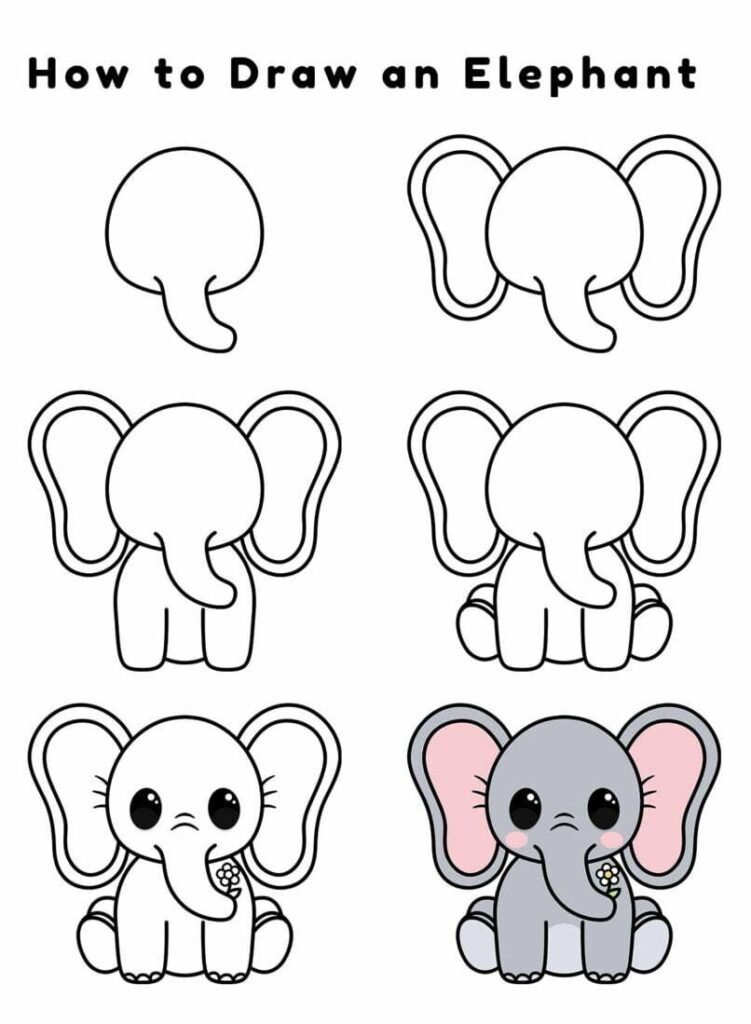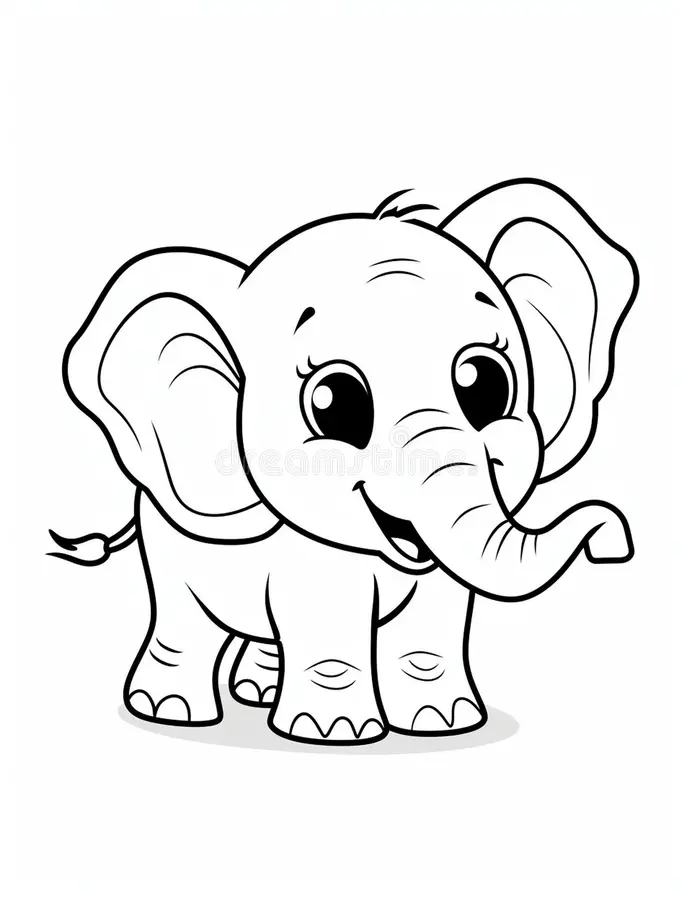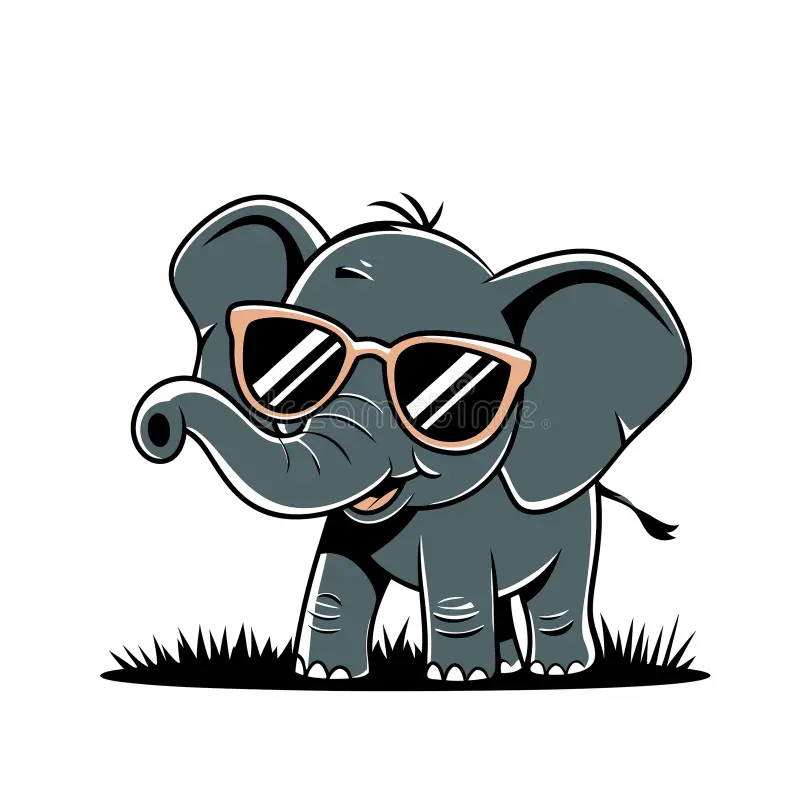Drawing elephants is not just about sketching a big, gray animal. There’s something magical about capturing the gentle giant on paper. With their large ears, long trunks, and wrinkled skin, elephants are some of the most majestic creatures in the animal kingdom. These qualities make elephants a fantastic subject for any artist. Whether you’re a beginner or an expert, the magic of drawing elephants lies in how you can bring their mighty yet gentle nature to life with just a few strokes of the pencil.
This post will help you discover the fun and educational aspects of drawing elephants. Whether you’re just starting to draw or you want to improve your skills, this guide will encourage your creativity and inspire you to make your own unique elephant drawings. We’ll cover everything from basic drawing techniques to adding fun details and using color to give your elephant personality. So grab your pencils and let’s dive into the magical world of elephant drawing!
1. Why Elephants Are a Magical Drawing Subject

Let’s see in detail why the elephant is magical in drawing.
Majestic Features of Elephants
Elephants have some of the most unique and recognizable features in the animal kingdom, making them a fun and easy subject to draw. Let’s take a closer look at why their large ears, trunks, and tusks are perfect for any artist.
- Large Ears and Trunks: Elephants have huge ears that look like big, floppy fans. These ears help the elephant keep cool in hot climates. When drawing, you can have a lot of fun exaggerating the size of the ears and trunk to make your elephant look even more lovable. The trunk is also a very versatile feature—it can be curved, held high, or wrapped around something. These options give you plenty of chances to experiment with different poses.
- Tusks and Wrinkles: An elephant’s tusks are long, curved, and strong, adding to the creature’s powerful appearance. Their skin is full of folds and wrinkles, making them not only interesting to draw but also a great way to practice adding texture to your art. With just a few lines, you can bring an elephant’s skin to life!
Elephants in Culture and Art
Elephants have always been an important part of art and culture. For centuries, people from all over the world have used elephants in their stories, paintings, and sculptures.
- Historical Significance: In many cultures, elephants are symbols of strength, wisdom, and good luck. In ancient India, elephants were depicted in religious art, and the famous deity Ganesha, the god of wisdom, is often shown with the head of an elephant. These ancient artworks show how important elephants have been in shaping the stories of people around the world.
- Modern Interpretations: Today, elephants still play an important role in art. Artists often draw elephants in fun, playful ways, showing them in cartoonish forms or adding imaginative details. The stories of elephants, like Dumbo, show us how elephants have inspired creativity in modern movies, books, and illustrations.
Emotional Connection
There’s more to elephants than their appearance. These animals are known for their intelligence, social behavior, and gentle nature. Many people feel a deep emotional connection to elephants, and that connection can be seen in their artwork.
- Symbolism: Elephants often represent qualities like wisdom, strength, and good fortune. This makes them perfect subjects for conveying powerful emotions in drawings. Whether it’s a calm and peaceful expression or a playful and curious pose, an elephant can help tell a story with its face and body language.
- Relatability: Kids and adults alike connect with elephants because they’re not just big and strong, they are also nurturing and protective, especially when it comes to their families. This emotional depth makes drawing elephants even more meaningful.
2. Getting Started with Elephant Drawings
Now that we know why elephants are so magical to draw, let’s start creating our own elephant drawings. Don’t worry if you’re a beginner! We’ll guide you step by step.
Step-by-Step Drawing Guide

Drawing an elephant doesn’t have to be hard. Let’s break it down into simple steps!
- Step 1: Begin with Basic Shapes Start with an oval for the elephant’s body. You can draw a big oval shape in the middle of your paper. Then, add a smaller circle above the body for the head. Don’t worry about making it perfect—just think of it as a rough sketch to get started!
- Step 2: Sketch the Trunk, Ears, and Legs Next, add the trunk! Draw a long, curved line that extends from the bottom of the head. The trunk should be thick at the top and narrow at the tip. For the ears, draw two large, floppy shapes on either side of the head. Elephants have big, floppy ears, so make them big and fun! Add four thick legs, and remember that elephants have large, sturdy feet.
- Step 3: Add Details Like Eyes, Tusks, and Wrinkles Now, let’s make the elephant look even more realistic. Draw two small circles for the eyes and add some tusks coming out from either side of the trunk. You can add wrinkles on the elephant’s skin to show the texture and help it look more lifelike. Elephants have many folds in their skin, so you can add lots of lines for that wrinkled effect.
- Step 4: Final Touches with Shading or Colors Finally, you can add shading to your drawing to make it look more three-dimensional. Use light, soft strokes to shade in the elephant’s body and under the trunk. If you’d like, you can add some fun colors! Elephants are typically gray, but you can use any color you like to give your elephant a special touch.
Tips for Beginners
If you’re just starting to draw, here are some helpful tips:
- Start Simple: Don’t worry about making your elephant perfect at first. Begin with basic shapes, then refine your drawing as you go.
- Proportions Matter: Keep the elephant’s proportions in mind. Make sure the trunk is long and the body is big and round.
- Don’t Worry About Perfection: Remember, every drawing is unique. Have fun with it and don’t be afraid to make mistakes!
3. Adding Personality and Fun Details

Now that we’ve drawn a basic elephant, let’s make it even more fun and creative by adding personality!
Creating Unique Elephant Expressions
- Facial Expressions: You can make your elephant look happy, surprised, or even a little mischievous! Play around with the eyes and mouth to show different emotions.
- Different Poses: Elephants can be drawn standing, walking, sitting, or even lying down. Try different poses to give your elephant more personality!
Fun Accessories
- Hats, Scarves, and Sunglasses: Want your elephant to look even more fun? Add a hat, scarf, or sunglasses to your drawing! Imagine an elephant wearing a funny hat or a stylish pair of shades.
- Other Fun Details: You can also add balloons, flowers, or jungle scenes around your elephant to create a fun setting.
Coloring Your Elephant
- Choosing Colors: While elephants are usually gray, you can experiment with other colors to make your elephant stand out. Try using blue, purple, or even rainbow colors!
- Creative Color Choices: Don’t be afraid to get creative with your color choices. You can make your elephant multicolored or add fun patterns like polka dots or stripes.
4. The Magic of Elephant Drawings in Art and Culture

Elephants have been part of art for centuries, and their magic continues to inspire us today. Let’s take a look at how elephants have appeared in art and culture.
Famous Elephant Art
- Dumbo: Dumbo, the flying elephant from Disney, is one of the most famous elephant characters in pop culture. He’s lovable, gentle, and full of heart—just like the real-life elephants!
- Artistic Representations: Elephants have also been featured in famous paintings, illustrations, and sculptures. Whether they’re realistic depictions or playful interpretations, elephants have inspired many artists.
Elephants as Symbols in Art
- Cultural Significance: In many cultures, elephants symbolize luck, strength, and wisdom. In some traditions, elephants are even seen as sacred creatures. You can incorporate these meanings into your own elephant drawings to give them deeper meaning.
- Spiritual Meaning: In religious art, elephants often represent spiritual wisdom. Elephants are revered in several spiritual traditions and are symbols of peace and prosperity.
The Influence of Elephants on Children’s Books and Media
Elephants have also inspired many beloved children’s books. Characters like Babar the Elephant and Horton from Horton Hears a Who! have taught kids important lessons about kindness, courage, and helping others.
5. Advanced Elephant Drawing Techniques

For those who want to take their elephant drawings to the next level, there are a few advanced techniques that can make your elephants look even more realistic and expressive. Let’s explore some of these techniques!
Adding Depth with Shading
- Light and Shadow: To make your elephant drawing look three-dimensional, you can use shading techniques. By adding shadows in the right places, like under the belly, around the trunk, or beneath the ears, you can give the elephant a sense of depth. Use soft, light strokes of your pencil to create a gentle shadow, making sure the light source is coming from one direction, such as the top or side of the elephant.
- Textures: Elephants have thick, wrinkled skin that gives them a unique texture. To create this effect in your drawing, try using small, curved lines or dotted strokes to mimic the roughness of their skin. This will make your elephant feel more realistic and detailed.
Using Mixed Media
- Combining Watercolors and Pencils: If you want to add color to your elephant drawings, try using a combination of watercolors and colored pencils. Start by painting the base colors with watercolor and then use colored pencils to add finer details, like wrinkles, shadows, and textures. This gives your drawing a vibrant, layered look and makes the elephant come to life.
- Digital Elephant Drawings: If you enjoy drawing on a tablet or computer, you can create beautiful elephant art digitally. There are many digital tools that allow you to draw with different brushes, colors, and textures. Experiment with digital techniques to create bright, colorful, and even animated elephants!
6. The Educational Value of Drawing Elephants
Drawing elephants is not just fun—it can also teach you valuable lessons about the animal itself and the world around you. Let’s look at how elephant drawing can be educational too!
Learning About Elephants Through Art
- Scientific Accuracy: Drawing elephants gives you a chance to learn about their anatomy and physical features. When you draw, you’ll notice how elephants have large, floppy ears, thick skin, and long trunks. This process helps you understand more about the real-life animals, their habitats, and how they move.
- Understanding Nature: Learning to draw elephants is a great way to connect to the natural world. By drawing these majestic creatures, you can appreciate the beauty of wildlife and nature. Plus, it helps you understand the importance of protecting animals and their environments.
Building Fine Motor Skills
Drawing helps kids develop fine motor skills by practicing hand-eye coordination. When you draw elephants, you’re not only improving your ability to sketch but also enhancing your ability to control your pencil and focus on details. These skills can be helpful in other areas of life, such as writing, sports, and even music!
Creativity and Storytelling
- Encouraging Storytelling: Elephant drawings can be a great starting point for creating stories. You can imagine your elephant going on adventures or meeting other animals in the wild. By incorporating your imagination, you can create a world for your elephants to live in, and tell exciting stories through your artwork!
7. The Global Appeal of Elephant Drawings
Elephants are loved all over the world, and their images appear in art from many different cultures. Let’s explore how elephants are represented globally and why they are so meaningful.
Elephants Around the World
- How Elephants Are Represented in Art: Elephants have been a part of art for centuries. In many cultures, elephants symbolize strength, wisdom, and peace. In African art, elephants are often shown as majestic creatures that represent the power of nature. In Asian cultures, elephants are revered for their wisdom and are seen in many traditional artworks.
- The Role of Elephants in African, Asian, and Western Artwork: In Africa, elephants are often featured in paintings, sculptures, and textiles, representing both power and protection. In Asia, especially in India, elephants hold spiritual significance, and their images are often seen in religious art. In Western culture, elephants have been the stars of popular cartoons and stories, from Disney’s Dumbo to Dr. Seuss’s Horton.
Elephants as Global Symbols
Elephants have also become global symbols of peace and conservation. Efforts to protect elephants from poaching and habitat destruction have made them symbols of wildlife protection. By drawing elephants, you’re joining a global movement to raise awareness about the need to protect these incredible animals.
Conclusion
Drawing elephants is a wonderful way to unleash your creativity while learning about the beauty of these magnificent creatures. Whether you’re just starting to draw or are an experienced artist, there’s always something new to discover about elephants and the magic they bring to the world of art.
By practicing different drawing techniques, adding your own unique touches, and sharing your artwork with others, you’ll continue to grow as an artist and deepen your connection to these gentle giants. The world of elephant drawing is endless, and each drawing you create is a magical experience.
So grab your pencil, start sketching, and let the magic of elephants inspire you to create art that’s as beautiful and unique as the creatures themselves!
